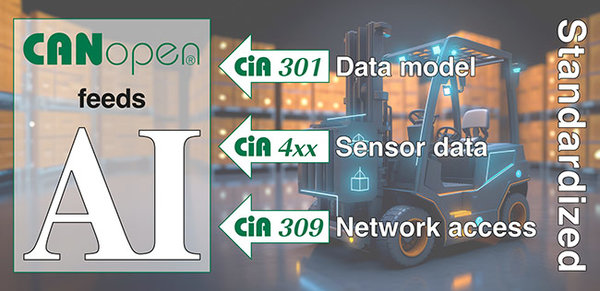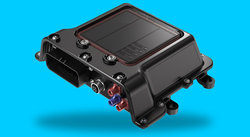CAN Info Mail
This monthly email is for all CAN fellows.
November 2023
A word from the CiA Managing Director

According to the Oxford Dictionary, artificial intelligence (AI) is the theory and development of computer systems able to perform tasks normally requiring human intelligence, such as visual perception, speech recognition, decision-making, and translation between languages. Already in 1956, AI was introduced as an academic discipline in a workshop at the Darmouth College (USA).
I wrote, as an editor, several articles about AI beginning of the 90ties. But then AI was for several years not more in the headlines of publications – with some exceptions, of course. Nowadays, AI is back: Everyone talks about ChatGPT and its competitors. ChatGPT stands for “Chatbot Generative Pre-trained Transformer”. It is an AI chatbot and thus a generative AI. OpenAI, the company behind ChatGPT, was originally founded by Elon Musk and Sam Altman, and in 2019, it secured a billion-dollar investment and cooperation from Microsoft. As a generative language and text-based chatbot, ChatGPT is capable of understanding written content – it can also compose texts itself. It works somewhat similar to interacting with a human. The AI understands the intention behind the written text, can engage in conversation with you, or even independently create texts and code.
But do not forget, AI does not lack shortcomings, which is why it still cannot replace a human, especially in decision-making. The overall data quality is rather subpar, lacking any verification mechanism to ensure the validity of used sources. Nevertheless, AI is already used in manufacturing operations: From quality management to product design. According to a study by Capgemini, more than 50 percent of top European manufacturers are currently implementing AI in some way. Germany leads, with 69 percent of manufacturers using it. In Japan that figure is 30 percent and in the United States it is 28 percent. China brings up the rear with 11 percent.
AI solutions need increasingly data to feed the AI algorithms. CANopen networks can provide this data. Sensors and measuring devices collect the data, CANopen host controllers pre-processes them, and standardized interfaces can be used to communicate with the AI engines. And vice versa, AI algorithms can improve the CANopen-connected actuators. Typical examples are AGVs (automated guided vehicles) and AMRs (autonomous mobile robots): AI can optimize AGV fleets regarding dispatching routes to maximize product throughput. Similar AI algorithms can be used to optimize throughput and energy consumption in elevators. Some of the needed input data is typically provided by CANopen devices and elevator cars and doors are actuated by other CANopen devices.
AI also can improve automatic welding solutions. Every welder knows how to adjust basic parameters such as amperage and line feed speeds according to different base materials, root gaps, and other variables. Nevertheless, welding is somehow unpredictable. AI-guided software can learn and teach the welding robot to do it better. This is even possible in manual welding, when the welder gets suggestions from a semi-automated equipment to do the welding in such a way that smoke is minimized. Recently, CiA has started to develop a CANopen profile for welding and cutting.
These are just some examples, in which “CANopen feeds AI”. Let’s talk about AI and CANopen in more detail during the SPS tradeshow in Nuremberg (November 14 to 16, 2023) at the CiA booth (hall 5, stand 410).

Program of the 18th international CAN Conference (iCC)
The iCC program committee chaired by Holger Zeltwanger, evaluated the submitted abstracts, selected the speakers, and grouped the papers to seven sessions. The iCC program is available online. The two-days conference is accompanied by a tabletop exhibition. In the first evening a diner is planned. This gives the attendees an opportunity for social networking.
The 18th iCC will take place in Baden-Baden, Germany (May 14 and 15, 2024). Parties interested in more details, sponsoring, or exhibiting should contact conferences(at)can-cia.org.
SIG 3,3-V transceiver: Inaugural meeting
The CiA IG (interest group) Lower layers is going to establish a SIG (special IG) to develop CiA specifications for 3,3-V transceivers. It is intended that 3,3-V components can be mixed with 5-V transceivers. In a first step, only CAN HS transceivers and CAN FD transceivers are considered. The inaugural meeting is scheduled on November 08, 2023 (13:00 to 15:00, UTC + 1). Interested parties (also non-members) should contact CiA office for details.
CiA technology day in Taiwan
This in-presence CiA technology day for the growing CiA-membership society in this country, is planned for November 21, 2023 in Kaohsiung (TW). The Rotary Taiwan is sponsoring the event. During the event, latest CiA activities and current items in CiA working groups will be presented. Topics give insight into CAN FD, CANopen, energy management options, as well as CAN XL developments. Further, CAN-based standards for road vehicles diagnostics (ISO 14229, ISO 15765), J1939, etc. are going to be discussed.
Registration is possible via email to events(at)can-cia.org.
SPS 2023: Meet CiA in hall 5
From November 14 to 16, the SPS 2023 exhibition opens its doors in the CiA’s home-town Nuremberg. Several CiA employees will be on site at the CiA booth (hall 5, stand 410). Get the latest CAN information, discuss current topics, or just say “Hello” to old friends! To make an appointment in advance, please contact exhibition(at)can-cia.org.
CAN Newsletter magazine
Visitors of the SPS tradeshow will have an opportunity to get a printed version of the September issue.
The September issue describes applications of drives in access control systems, pressure sensors in cooling, control of metering control valves, CAN nodes in satellites, and automation in vertical farms.
How to select the right encoders for safety-related motion control and CAN data acquisition are the further topics. The category engineering introduces the UDSonCAN diagnostic protocol and contents articles on functional safety in road vehicles as well as simplified ordering for CANopen contrast media injectors. The recent standards and specifications are also part of the issue.
The articles can be downloaded individually or you can download the entire magazine.
CAN Newsletter Online
Telematics units: For off-highway use
Bosch Rexroth has introduced a high-performance RCU (Rexroth Connectivity Unit) Series 20 with four CAN FD interfaces. It has also announced an entry-level RCU model.
- Automotive MCUs: Delivering MPU-like performance
- SPS 2023: CAN sensor connection on a PCB
- AC drive: For motor control in hydraulic applications
- Encoders and inclinometers: Improving solar systems
- BMS platform: Control unit comes with three CAN FD ports
New video on Youtube
- CANopen Lift webinar - 2023-10-10
- Chinese technology day - 2023-09-14
Advertisements
CAN- and CANopen-related educational training
Seminar onsite
- 2023-11-28: CAN und CANopen for newcomers (Nuremberg, DE) 1
Technology day onsite
- 2023-11-21: CiA technology day (Kaohsiung, TW) 2
Webinar
- 2023-11-08: Future of CANopen technologies 2
1 in German language
2 in English language
New CiA members since the last CAN Info Mail (CIM)
- Daco Scientific (GB)
- Insolem (FR)
- KEM Küppers Elektromechanik (DE)
- Lumissil Microsystems International (HK)
- NKE Marine Electronics (FR)
- Novosense (CN)
- SMAC (US)
CiA has 758 members (October 31, 2023)

